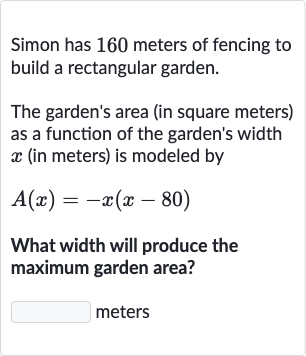Full solution
Q. Simon has meters of fencing to build a rectangular garden.The garden's area (in square meters) as a function of the garden's width (in meters) is modeled byWhat width will produce the maximum garden area? meters
- Analyze Function : To find the width that will produce the maximum garden area, we need to analyze the function . This is a quadratic function in the form of , where , , and . The maximum value of a quadratic function occurs at .
- Calculate Maximum Value: First, we calculate the value of at which reaches its maximum by using the formula . Here, and ..
- Identify Maximum Width: The width that will produce the maximum garden area is meters. This is because the vertex of the parabola represented by the quadratic function occurs at .
- Verify Maximum Point: We can verify that is indeed the width that maximizes the area by checking that the second derivative of is negative at , which would confirm that it is a maximum point. The second derivative of with respect to is , which is always negative, indicating that the function is concave down and thus has a maximum point at the vertex.
More problems from Ratio and Quadratic equation
QuestionGet tutor help
QuestionGet tutor help
QuestionGet tutor help
QuestionGet tutor help
QuestionGet tutor help
QuestionGet tutor help
QuestionGet tutor help
QuestionGet tutor help

